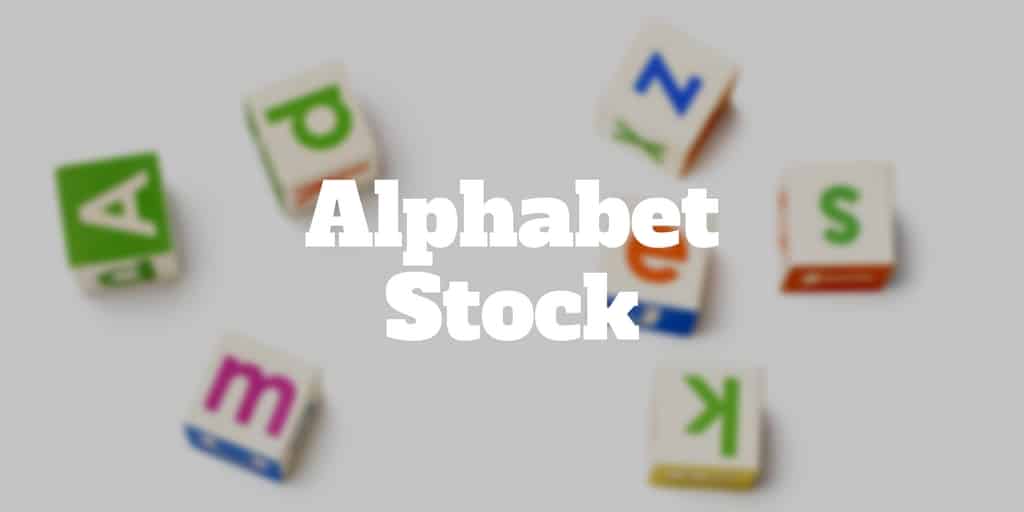

Alphabet is better known to most investors as Google. For virtually its entire operating history as a public company, Google held the dominant market share in search, but its name change offers insight into what else is to come from Google.
Alpha is a measure of performance on a risk-adjusted basis, so are Google co-founders Larry Page and Sergey Brin hinting that a bet on “Alpha-bet” will lead to alpha – or superior returns on a risk-adjusted basis?
To better understand the prospects for Alphabet, we analyze its financial statements and valuation metrics.
Alphabet Stock Price & Valuation
To make a buy or sell decision on Alphabet stock, the financial statements offers insights into where the share price is headed.
Quantitative research gives you insights into the operating performance and financial trajectory for Alphabet, while qualitative research informs you of the competitive landscape as well as future opportunities and markets in which the company competes.
QUANTITATIVE RESEARCH

Historically CPC figures have been volatile but revenues have steadily grown over time as the # of clicks has generally increased year over year.
As more content is produced and consumed in text and video form, more ads are served and Google is the go-to resource for YouTubers, bloggers, and publishers to monetize content.
By using a combination of valuation models, a fair value for Alphabet can be calculated.
- P/E Multiples
- Earnings Power Value
- 5 Year & 10 Year DCF Revenue Exit
- 5 Year & 10 Year DCF Growth Exit
- 5 Year & 10 Year DCF EBITDA Exit
- EBITDA Multiples
QUALITATIVE RESEARCH
For a company to sustain market beating returns, it needs to have a competitive advantage that is near impossible to disrupt.
Warren Buffett describes this competitive advantage as a moat, which can take many forms, including:
- Low cost advantage
- High switching costs
- Brand recognition
- Network effects
The moat Alphabet enjoys is its network effects and better technology. Millions of websites around the world serve Google ads, making it a tall order for any competitor to disrupt Alphabet.
Even if Alphabet lost a handful of customers who decided to switch to a competitor, millions of others would need to switch before a dent would be seen in its market share.
And its extensive network drives just one component of revenue. Every query in its search box displays ads, which when clicked lead to incremental revenue.
Plus, Alphabet’s web property, YouTube is the dominant leader in video content, which enables Alphabet to monetize clicks on streaming video content too.
By establishing such dominant market share positions in utilities that consumers use daily, the hurdle for competitors is perilously high, and the future revenue and earnings growth for Alphabet is bright.
Alphabet Stock Price History
Alphabet stock price history has over long time periods sustained a long term bullish trend as its intrinsic value has risen with ever higher earnings and revenues.
In its early years, Alphabet – or Google – share price was volatile, swinging up and down by as much as 20% in just a few months.
As the company has matured and earnings have become more predictable, volatility has subsided somewhat but make no mistake about it, Alphabet share price can surprise from time to time in a big way.
The decision to buy and hold Alphabet is as much a personal one about withstanding the rollercoaster ride of share price fluctuations as it is about the fundamentals.
Examining a 10 year Alphabet stock chart, you can see the price swings over time can be large in both directions but equally the indisputable long term trend has been higher.
>> Related: Discover How To Research Stocks
If you're worried "transitory" inflation and "mild" recession will be worse than expected...
Gold and commodities helped during volatile times. BUT one asset 99% of investors miss helps protect your portfolio and has outpaced the S&P by 131% over the past 26 years.
Art.
And while historically you've needed millions to invest, one platform lets you invest in famous paintings for as little as $20.
You can skip the waitlist and become a Masterworks member today with this private link.
See important Reg A disclosures: Masterworks.com/cd
Quantitative Research:
Alphabet/Google Revenues & Earnings
Even Warren Buffett had to admit the business model enjoyed by Alphabet is enviable – each additional click after covering costs leads to ever higher profits and profit margins.
Although Bing has slowly crept up on Google Search, the dominant market share by far is held by Google. The Bing Network counts over 500 million unique searches worldwide but Google still holds a 63%+ market share position.
Alphabet revenues over time reflect the enormous growth of Google’s ad network, YouTube, Gmail and other dominant areas.
Where Alphabet shines is how well it converts revenues to earnings. After its fixed costs are covered, Alphabet enjoys incremental profits from each click, the primary revenue and earnings driver.
➤ Free Guide: 5 Ways To Automate Your Retirement
Alphabet P/E Ratio
Alphabet has historically traded at high P/E multiples reflecting expectations for rapid earnings growth for the foreseeable future.
When companies are growing revenues fast as Alphabet has historically, price-to-earnings multiples can be lofty to reflect a share price premium and expectations for rapid earnings growth.
As a relatively mature company, Alphabet still trades at a fairly lofty P/E multiple.
>> Related: What You Need To Know Before Selling A Stock
Alphabet Return On Invested Capital (ROIC)
ROIC measures profitability and the value-creating potential of Alphabet after factoring in the amount of capital invested.
ROIC or return on invested capital assesses the return that an investment generates for shareholders and bondholders. It is one of the most closely watched financial metrics by fundamental investors managing large sums of money.
Alphabet has sustained a double-digit % ROIC which infers that it is doing an excellent job creating value.
>> Related: What Are The Best Value Stocks?
We could be facing one of the harshest economic challenges ever experienced thanks to an incompetent government and severe global unrest. If you aren't proactive, you could see yourself and your family become another financial casualty. But, the Inflation Survival Plan has you covered. Learn insider tips and tricks, IRS loopholes and more that will help your finances soar.
Take 15 Seconds to get the FREE Inflation Survival Plan and ensure your family's financial security.
Alphabet Debt To Total Capital
Technology companies often have low debt to capital levels and Alphabet is no different. Unlike companies laden with debt who suffer in high interest rate environments from higher loan repayments, Alphabet is not anchored by a heavy debt load.
High debt levels can be a problem for companies, especially after a Fed rate hike when saddled with variable rate loans.
Alphabet has no such issues with minuscule debt to total capital percentage levels.
Alphabet WACC
Bondholders and shareholders demand a yield to satisfy them. Generally bondholders require smaller yields than shareholders, who take on more risk.
The weighted average cost of capital, or WACC, provides insight into whether the levels demanded by these stakeholders are met.
For example, if a company receives $50 million from shareholders and $50 million from bondholders to operate, with shareholders earning a 12% return and bondholders receiving a 6% yield, the WACC would be 9%.
Alphabet Financials
Below you can see an example of 5 year DCF Revenue Exit model for Alphabet:
Have you invested in Google stock historically or Alphabet stock more recently? What investing lessons have you learned? Share your investing stories with us in the comments section below. We would love to hear from you.
>> Is Twitter Stock A Buy Or A Sell?
>> When Will The Stock Market Crash?
>> Is Facebook Stock A Buy Or A Sell?
Mr. Market is fickle and emotional... After ten years of going up in a nearly unbroken line, he abruptly decided to reverse course...
And usher in a bear market that has crushed portfolios — But while most investors were going through the worst year since the Global Financial Crisis...
A small group of 3,700 people had the chance to collect instant "bonus payouts" courtesy of Mr. Market every week.
All thanks to a method most investors have no idea about… watch this demo showing how it works.








